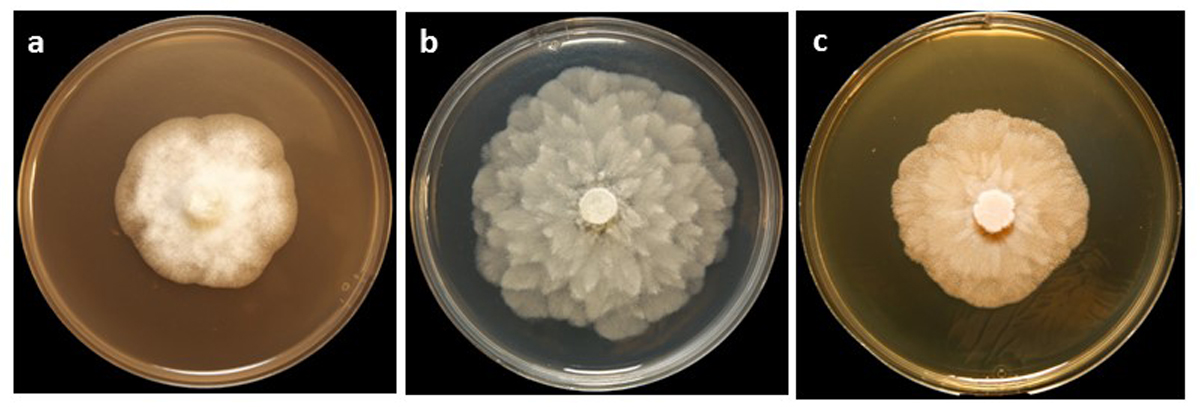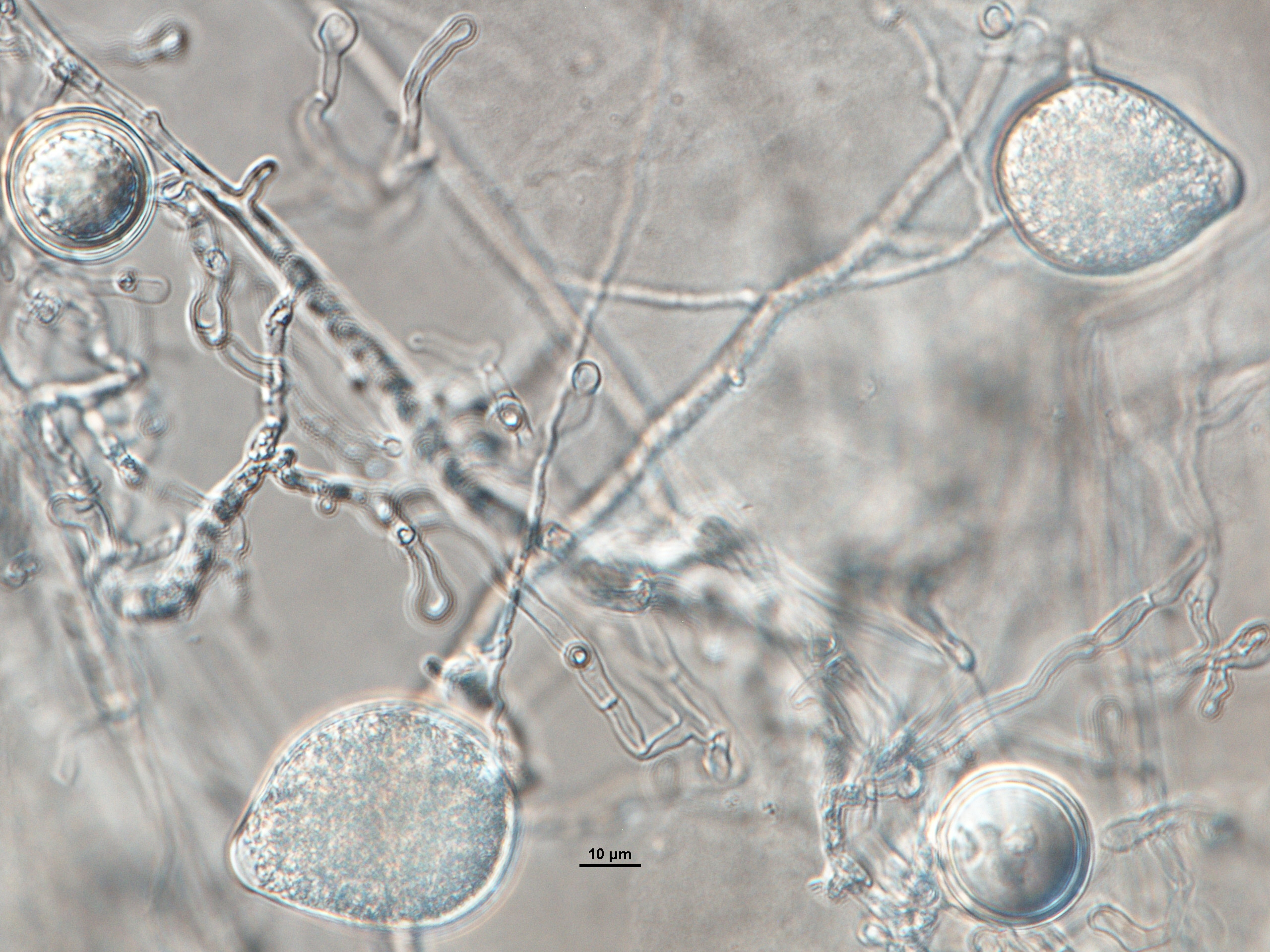Phytophthora citricola
|
Phytophthora spp. in subclade 2c: portion of the seven-loci ML phylogeny featuring the type cultures of 212 described species (by T. Bourret). Notice the position of P. citricola Ex-type CBS 221.88 = S&T BL 34. Gloria Abad, USDA S&T.
|
|
Phytophthora spp. in subclade 2c: Morphological Tabular key (PDF) and Tabular key legends (PDF) in IDphy2 KEY SECTION. Notice the data of P. citricola Ex-type CBS 221.88 = S&T BL 34. Gloria Abad, USDA S&T.
|
|
Phytophthora citricola (CPHST BL 34) colonies of the ex-type grown for 7 days on (a) V8® Agar, (b) potato dextrose agar, and (c) malt extract agar; photo by Clinton Greub, Krysta Jennings, and Leandra Knight, USDA-APHIS-PPQ |
|
Phytophthora citricola (CPHST BL 34) sexual phase formed on hemp seed agar plus Udo's oil (a-c): (a, b) smooth-walled oogonia with tapered bases and paragynous antheridia and plerotic oospores, (c) smooth-walled oogonium with paragynous antheridium and plerotic oospore; photos by Gloria Abad, USDA-APHIS-PPQ. |
|
Phytophthora citricola (CPHST BL 34) asexual phase formed on V8 agar flooded with soil extract (a-c): (a) sporangia originated in simple sporangiophores and oospores, (b) semipapillate ovoid persistent sporangium and oospore, (c) semipapillate persistent ovoid sporangia and oospores; photos by Gloria Abad, USDA-APHIS-PPQ. |
|
Phytophthora citricola (CPHST BL 34) asexual phase formed on V8 agar flooded with soil extract: sporangia originated in simple sporangiophores and oospores; photo by Gloria Abad, USDA-APHIS-PPQ. |
|
Phytophthora citricola (CPHST BL 34) asexual phase formed on V8 agar flooded with soil extract: semipapillate ovoid persistent sporangium and oospore; photo by Gloria Abad, USDA-APHIS-PPQ. |
|
Phytophthora citricola (CPHST BL 34) asexual phase formed on V8 agar flooded with soil extract: semipapillate persistent ovoid sporangia and oospores; photo by Gloria Abad, USDA-APHIS-PPQ. |
|
Phytophthora citricola (CPHST BL 34) sexual phase formed on hemp seed agar plus Udo's oil: smooth-walled oogonium with tapered base and paragynous antheridium and plerotic oospore; photo by Gloria Abad, USDA-APHIS-PPQ. |
|
Phytophthora citricola (CPHST BL 34) sexual phase formed on hemp seed agar plus Udo's oil: smooth-walled oogonium with paragynous antheridium and plerotic oospore; photo by Gloria Abad, USDA-APHIS-PPQ. |
|
Phytophthora citricola (CPHST BL 34) sexual phase formed on hemp seed agar plus Udo's oil: smooth-walled oogonium with tapered base and paragynous antheridium and plerotic oospore; photo by Gloria Abad, USDA-APHIS-PPQ. |
Name and publication
Phytophthora citricola Sawada (1927)
Sawada K. 1927. Descriptive catalogue of the Formosan fungi III. Report of the Department of Agriculture, Government Research Institute of Formosa 27: 1–62.
Nomenclature
Mycobank
Typification
from Sawada (1927)
Type: TAIWAN, Formosa from fruit of Citrus sinensis, collected in 1927 IMI 21173
Ex-type: CBS 221.88
NOTE: Translation from the original manuscript in Japanese into English was provided by Dr. Motoaki Tojo at Osaka Prefecture of Japan (G. Abad 4.7.2018).
Ex-type in other collections
(ET) CBS 221.88, NRRL 64191, ATCC 60440 MCI, CABI IMI21173 (PA), WPC P0716 P1689, S&T BL 34 (Abad), 33H8 (Hong), NCTC3057, p396 (Gallegly)
NOTE: Caution should be taken when identifying Phytophthora citricola as there are numerous misidentifications of this species in NCBI. It is recommended that sequences from specimens of the ex-type be used to correctly identify to species level.
Molecular identification
Voucher sequences for barcoding genes (ITS rDNA and COI) of the ex-type (see Molecular protocols page)
Phytophthora citricola isolate CPHST BL 34 (= P0716 WPC) = ITS rDNA MG865475, COI MH136871
Voucher sequences for Molecular Toolbox with seven genes (ITS, β-tub, COI, EF1α, HSP90, L10, and YPT1
(see Molecular protocols page) (In Progress)
Voucher sequences for Metabarcoding High-throughput Sequencing (HTS) Technologies [Molecular Operational Taxonomic Unit (MOTU)]
(see Molecular protocols page) (In Progress)
Sequences with multiple genes for ex-type in other sources
- NCBI: Phytophthora citricola CPHST BL 34
- NCBI: Phytophthora citricola CBS 221.88
- NCBI: Phytophthora citricola P0716
- NCBI: Phytophthora citricola 33H8
- EPPO-Q-bank: Phytophthora citricola CBS 221.88
- BOLDSYSTEMS: Phytophthora citricola CBS2218 = OOMYA059-07, OOMYA 498-08, P0716 = PHYTO009-10 (barcoding COI & ITS)
Position in multigenic phylogeny with 7 genes (ITS, β-tub, COI, EF1α, HSP90, L10, and YPT1)
Clade 2c
Genome sequence
Phytophthora citricola strain ex-type P0716. Accession genome USDA_Pcit_BL34_1.0 reference, BioProject PRJNA555328, USDA-APHIS-PPQ-S&T (2019), Srivastava et al 2022
Morphological identification
Colonies and cardinal temperatures
Colonies on V8-A, PDA, and MEA with chrysanthemum growth pattern, on PDA chrysanthemum with sparse aerial myceliummycelium:
mass of hyphae constituting the body, or thallus, of fungi and oomycetes; in <em>Phytophthora</em> species, mycelia is coenocytic
. Minimum growth temperature 3°C, optimum 24°C, maximum 30°C.
Conditions for growth and sporulation
Sporangia and oosporesoospores:
zygote or thick-walled spore that forms within the oogonium after fertilization by the antheridium; may be long-lived
abundantly produced in V8 agar under 10% soil solution.
Asexual phase
SporangiaSporangia:
sac within which zoospores form, especially when water is cooled to about 10°C below ambient temperature; in solid substrates, sporangia usually germinate by germ tubes
semipapillatesemipapillate:
pertaining to the production of shallow having papilla that are not well developed, shallow and less nipple-like than fully papillate structures
and persistentpersistent:
pertaining to sporangia that remain attached to the sporangiophore and do not separate or detach easily (cf. caducous)
; ovoidovoid:
egg-shaped, with the widest part at the base of the sporangium and the narrow part at the apex
, globoseglobose:
having a rounded form resembling that of a sphere
, ellipsoidellipsoid:
refers to a solid body that forms an ellipse in the longitudinal plane and a circle in cross section; many fungal spores are ellipsoidal or elliptic
, obpyriformobpyriform:
inversely pear-shaped, i.e. with the widest part at the point of attachment (cf. pyriform)
, and distorted shapes (28–78 x 21–47 µm) and bipapillate originated in single or sympodiallysympodially:
at the foot of; referring to a sporangiophore that emerges externally from the base of the previous sporangium
branched sporangiophores. Hyphal swellings absent. Chlamydospores absent.
Sexual phase
Homothallic. Oogonia smooth-walled, round base, occasionally tapered basetapered base:
pertaining to the base of a sporangium or oogonium; funnel-shaped
(21–44 µm diam.); antheridiaantheridia:
the male gametangium; a multinucleate, swollen hyphal tip affixed firmly to the wall of the female gametangium (the oogonium)
paragynousparagynous:
pertaining to the sexual stage in which the antheridium is attached to the side of the oogonium (cf. amphigynous)
, rarely amphyginous (12–13 x 8–10 µm diam) attached near the oogonial stalks; oosporesoospores:
zygote or thick-walled spore that forms within the oogonium after fertilization by the antheridium; may be long-lived
predominantly pleroticplerotic:
pertaining to an oospore that fills the oogonium (cf. aplerotic)
(18–38 µm diam.) with thick oosporeoospore:
zygote or thick-walled spore that forms within the oogonium after fertilization by the antheridium; may be long-lived
wall.
Most typical characters
Phytophthora citricola is characterized by the presence of mostly ovoidovoid:
egg-shaped, with the widest part at the base of the sporangium and the narrow part at the apex
semipapillate sporangiasporangia:
sac within which zoospores form, especially when water is cooled to about 10°C below ambient temperature; in solid substrates, sporangia usually germinate by germ tubes
, paragynousparagynous:
pertaining to the sexual stage in which the antheridium is attached to the side of the oogonium (cf. amphigynous)
antheridiaantheridia:
the male gametangium; a multinucleate, swollen hyphal tip affixed firmly to the wall of the female gametangium (the oogonium)
attached near the oogonial stalks, and oogoniaoogonia:
the female gametangium in which the oospore forms after fertilization by the antheridium
occasionally with tapered basetapered base:
pertaining to the base of a sporangium or oogonium; funnel-shaped
.
Specimen(s) evaluated
Phytophthora citricola CPHST BL 34, duplicate of P0716 (World Oomycetes/Phytophthora Collection)
Hosts and distribution
NOTE: Information for P. citricola in many sources appears to correspond to P. plurivora, P. pini and other species in P. citricola "complex" (see phylogenetic tree figure).
Most isolates identified as P. citricola prior to 2009 are most likely to correspond to Phytophthora plurivora or P. pini. It is possible that the correct distribution for P. citricola is in Argentina, Australia, Canada, Japan, China, South Africa, Spain, Taiwan, and the USA (CA) (based on available sequences in NCBI). These sequences are associated with citrus and hybrid verbena (G. Abad, 9.12.18).
Distribution: cosmopolitan
Substrate: roots, fruits, stems, bark of trunks
Disease note: brown rot of oranges, black root of hops, root rot and cane die-back of raspberry, die-back of rhododendron, and basal rot of tomato seedlings (Waterhouse & Waterston 1966)
Hosts: 75 genera in 38 families
Retrieved January 29, 2018 from U.S. National Fungus Collections Nomenclature Database.
Quarantine status
Phytophthora citricola is listed in the U.S. Regulated Plant Pest Table (last modified Nov. 15, 2017).
Additional references and links
Scott PM, Burgess TI, Barber PA, Shearer BL, Stukely MJC, Hardy GE, and Jung T. 2009. Phytophthora multivora sp. nov., a new species recovered from declining Eucalyptus, Banksia, Agonis and other plant species in Western Australia. Persoonia 22: 1-13.
Jung T and Burgess TI. 2009. Re-evaluation of Phytophthora citricola isolates from multiple woody hosts in Europe and North America reveals a new species, Phytophthora plurivora sp. nov. Persoonia 22: 95-100.
- SMML USDA-ARS: Phytophthora citricola
- EPPO Global Database: Phytophthora citricola
- Forest Phytophthoras of the world: Phytophthora citricola
- CABI Digital Library: Phytophthora citricola
- Encyclopedia of Life (EOL): Phytophthora citricola
- Index Fungorum (IF): Phytophthora citricola
- Google All Phytophthora citricola
- Google Images Phytophthora citricola
- Google Scholar Phytophthora citricola
Fact sheet author
Z. Gloria Abad, Ph.D., USDA-APHIS-PPQ-S&T Plant Pathogen Confirmatory Diagnostics Laboratory (PPCDL), United States of America.










